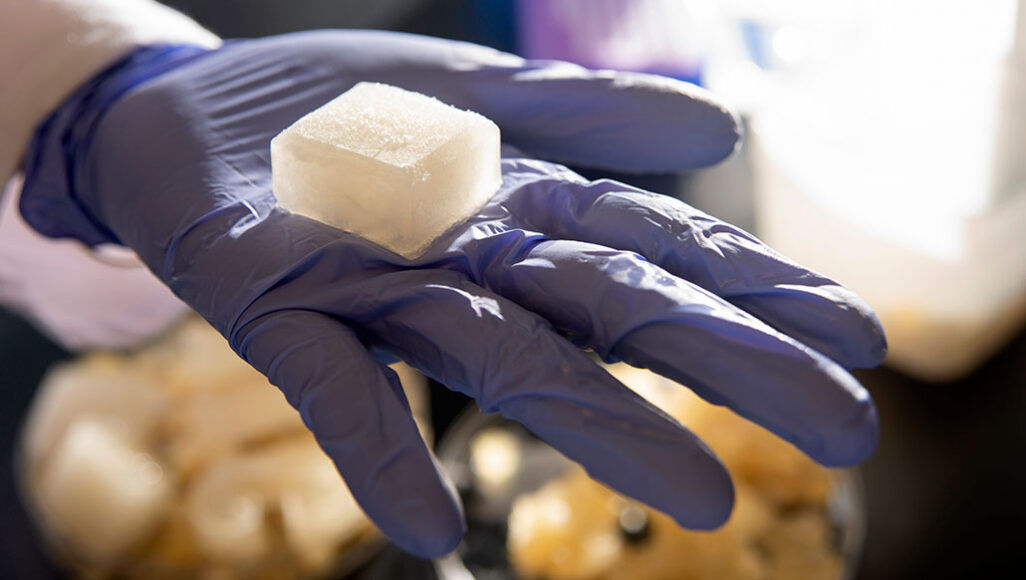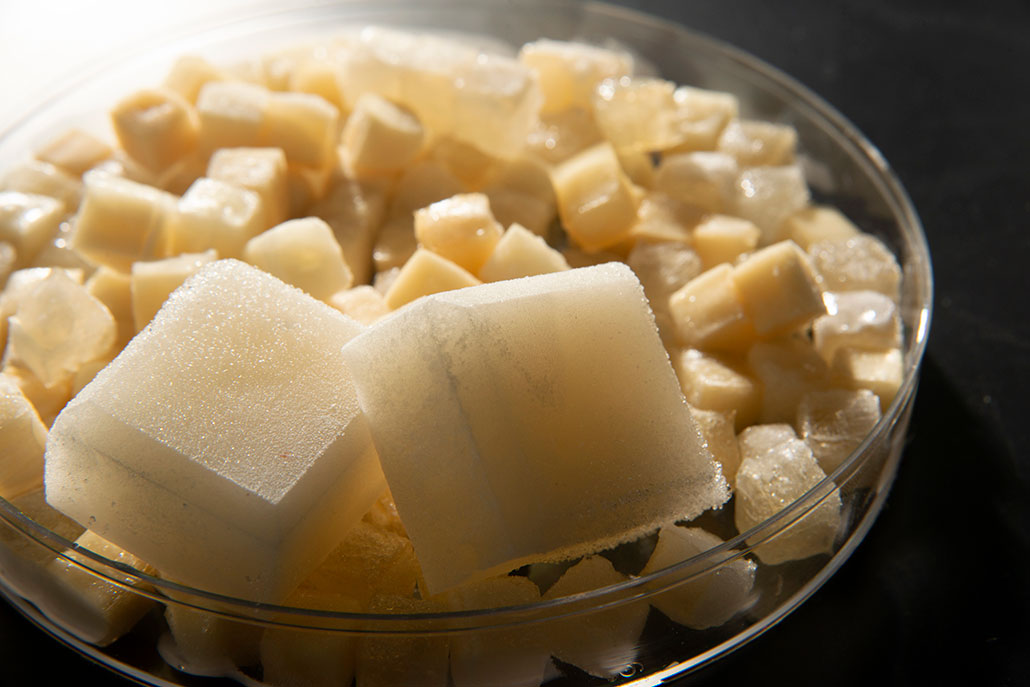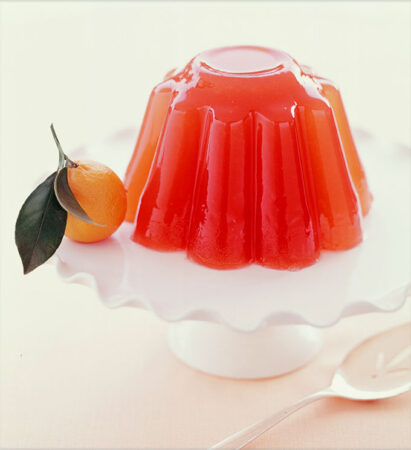Could reusable ‘jelly ice’ cubes replace regular ice?
The new ‘ice’ may provide a moldable and eco-friendly new option for chilling food and more

University of California, Davis researchers say these innovative new cooling cubes are anti-microbial and could reduce food storage cross-contamination.
Gregory Urquiaga/UC Davis
“Jelly” ice may one day replace the cubes chilling your cold drink. These reusable cubes trap water inside their sponge-like structure. That water can freeze but it can’t escape. Researchers at the University of California, Davis, hope their innovation may open new frontiers in food-cooling tech.
Jelly ice cubes are made of hydrogel — meaning “water-gel.” Hydrogel sounds technical. But you’ve probably eaten hydrogel before — Jell-O. You can even freeze that popular food. But there’s a problem. Once thawed, it turns to goop.

Not jelly ice cubes. They can be frozen and thawed, again and again. They’re also eco-friendly. Re-using them can save water. Plus, the hydrogel is biodegradable. Unlike plastic freezer packs, at the end of their useful life, they won’t leave behind long-lived plastic waste. They’re even compostable. After about 10 uses, you can use these cubes to boost garden growth.
Finally, they may make storage of frozen food cleaner. In fact, that’s where “the original idea started,” says Luxin Wang. She’s a microbiologist on the UC Davis team. As regular ice melts, bacteria can hitch a ride in that water to other foods stored in the same place. In this way, “it can cross-contaminate,” Wang says. But the hydrogel won’t turn liquid again. After use, it can even be rinsed clean with dilute bleach.
The team described its hydrogel ice cubes in a pair of papers on November 22. The research was published in ACS Sustainable Chemistry & Engineering.
Icy alternative
Just like ordinary ice, hydrogel’s cooling agent is water.
Ice absorbs heat, leaving things around it colder. Think of “cold” as just the absence of heat. When holding an ice cube, it feels like cold moves into your hand from the ice. But that cold feeling really comes from the heat moving out of your hand. When ice absorbs enough heat, it melts. But in the jelly ice cubes, Wang explains, the water is “trapped in the gel structure.”
The team compared its hydrogel’s ability to chill food — its “cooling efficiency” — with normal ice. First, they packed food samples into foam-insulated containers and chilled the food with jelly ice cubes or regular ice. Sensors measured changes in the food’s temperature. Normal ice worked better, but not by much. For example, after 50 minutes, the temperature of an ice-cooled sample was 3.4º Celsius (38º Fahrenheit). The gel-cooled sample was 4.4 ºC (40 ºF).
They also tested the hydrogel’s strength. Its sponge structure is made mostly of a protein called gelatin (just as in Jell-O). Hydrogels with a higher gelatin percentage were stronger but showed lower cooling efficiency. Tests revealed that hydrogels with 10 percent gelatin showed the best balance of cooling and strength.
During manufacture, jelly ice cubes can be molded into any shape. And that’s what has research, medical and food companies interested.
“We’ve gotten emails from lab managers,” Wang says. “They say, ‘That’s cool. Maybe you can make it this shape?’ And they send us pictures.”
For example, small ball shapes could be used as a chilly shipping material. Or perhaps hydrogel could be used to hold test tubes. When scientists need test tubes to stay cold outside the freezer, they often put them into a tub of ice. But maybe, Wang says, the gel instead could be fashioned into “a shape where we could put the test tubes in it.”
A work in progress
Jelly ice cubes aren’t yet ready for prime time. “This is a prototype,” Wang says. “As we move forward, there will be additional improvements.”
Price may be one downside. Compared to regular ice, “mostly [the gel] will not be cheaper,” Wang says. At least not initially. But options for cutting costs exist — such as if it’s reused many times, for example. The team is already working on that. Wang says a new study is showing better gel stability due to different types of connections being created between proteins in the gel’s sponge structure.
Another problem may be the use of gelatin itself. It’s an animal product and some people, such as vegetarians, won’t eat gelatin, says Michael Hickner. He teaches materials science at Penn State University in University Park. With these cubes, he notes, “You could get gelatin on your food that you don’t want.”

Polymer scientist Irina Savina at the University of Brighton in England also has concerns. “Probably it is good to have a cooling material that doesn’t leak; I will agree with that.” But cleaning with bleach could be a problem, she says. You don’t want to get bleach in your food, but the gelatin could adsorb bleach and release it when it touches your food. She has another concern. “Gelatin itself is a food for microbes.”
Vladimir Lozinsky is a polymer scientist at the Russian Academy of Sciences in Moscow. He echoes Savina’s point. “I worry the thawed cubes could be a nutritional source for microbes,” he says — including ones that can make you sick. Even without meltwater, the cubes might still contact food directly. And that, he worries, “could be a problem.”
Hickner agrees there are problems to work out. But he also imagines possibilities for far-future applications, like “food innovation.”
Freezing food can affect its texture. Especially when it comes to something like meat, which is made of intact cells. “Freezing destroys cells by making long, knifelike ice crystals,” says Hickner at Penn State. Working out ways out to reduce damage caused by the freezing process could open up new possibilities. And in this hydrogel study, “they’ve used polymers to control the size of the ice crystals. That makes all the difference,” he says. Using a gelatin hydrogel may be a “nice environmentally friendly way to do this without using really exotic preservatives.”
The eco-friendly potential of the cubes is the “big goal,” according to Wang. The hydrogel could promote a “circular economy,” she says. “When you use up something, such as these cubes, they could go to back to the environment, with minimal footprint on the Earth.”
This is one in a series presenting news on technology and innovation, made possible with generous support from the Lemelson Foundation.







